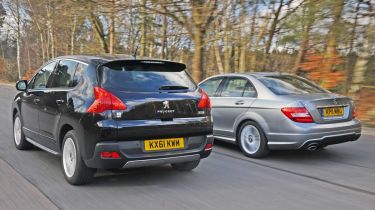Peugeot 3008 vs Merc C-Class
Price also puts hybrid in contention with compact executive cars, so we bring it together with one of the best
At first glance, our second shoot-out might seem like a mismatch – but any company car buyer drawn to the Peugeot’s low running costs might also be considering a German saloon. So how does the HYbrid4 stack up against the Mercedes C-Class?
Powered by a 2.1-litre diesel, the C220 CDI comes close to matching the 3008’s efficiency. It returns a claimed 64.2mpg fuel economy and emits only 117g/km of CO2 if you opt for the smallest 16-inch wheels, all while offering similar performance.
Without a doubt, it’s the more desirable of the pair, and while the Sport in our pictures offers more visual clout than the Elegance car we tested, every C-Class has a dynamic, purposeful stance. That’s partly down to the difference in dimensions, as the Mercedes is 226mm longer and 195mm lower than the Peugeot, and as a result it’s not as flexible inside.
Folding seats are a £250 optional extra, but the 475-litre boot is generous enough, and a longer wheelbase means that there’s plenty of kneeroom in the back, even if the low roofline limits headroom.
Behind the wheel of the Mercedes, you’re surrounded by soft-touch materials, and the interior upgrades that came with last year’s facelift really make their presence felt. The circular colour display housed in the large central speedo is clear and concise, and means you rarely have to take your eyes off the road.
Used - available now

2020 Fiat
500
69,035 milesManualPetrol1.2L
Cash £5,695
2016 Tesla
Model S
78,000 milesAutomaticElectric
Cash £18,999
2024 Kia
Stonic
39,731 milesAutomaticPetrol1.0L
Cash £14,999
2024 Skoda
Kodiaq
24,074 milesAutomaticPetrol2.0L
Cash £31,000It’s a more driver-orientated set-up than the 3008’s, and is superbly built. While the Peugeot is better-equipped as standard, the HYbrid4’s cabin feels brittle and fussy by comparison. Our only niggle is with the C-Class’ pedals, which are offset to the right due to the awkward foot-operated parking brake.
Another issue with the Mercedes is the extensive options list. The Elegance model we tested came with cruise control, artificial leather and Bluetooth as standard, but the intuitive COMAND navigation system is an extra (at a hefty £1,995) – as are the DAB digital radio (£335) and heated seats (£330).
Another option worth considering is the seven-speed automatic box. Smooth changes mean it’s more relaxing than the automated manual in the 3008, but it dents the Merc’s fuel economy and adds £1,500 to the price.
All this equipment comes as standard on the HYbrid4 Peugeot, but at £28,495, it’s an eye-watering £4,500 more expensive than the priciest conventional diesel 3008.
Driving through town, you can begin to justify paying so much for the Peugeot’s clever technology – the hybrid powertrain is constantly working, and you can spend long periods with the engine off, nudging gently along using only the electric motor.
When the diesel engine does fire up, the gruff rumble is disconcerting, especially if you’re used to quieter petrol hybrids, but the harsh ride and poor turning circle make the 3008 feel cumbersome in tight city traffic. The gearbox also hampers the Peugeot’s progress.
Even with the electric motor smoothing changes, it’s unresponsive, and shifts can be jerky unless you’re delicate with your inputs. You have to work harder in the Mercedes, which has long gear ratios for maximum economy, but because it’s narrower and 200kg lighter, it’s the more comfortable and capable car around town.
The C220 CDI really comes into its own on the motorway. The lack of wind and road noise and softly sprung suspension make driving long distances a breeze, and as our in-gear tests proved, the punchy engine means the Mercedes is far better when it comes to overtaking slower traffic.
In contrast, the 3008 is least impressive on the motorway. The electric motor rarely gets used while cruising, and unwanted road and wind noise spoil comfort. It did return better economy than the C-Class, but not by a huge margin.
So if you regularly do long trips, the Mercedes is the wiser choice – yet it’s quite expensive, so this will be a close contest.







